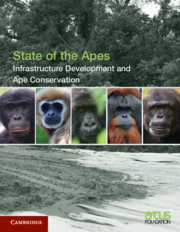
-
Select format
-
- Publisher:
- Cambridge University Press
- Publication date:
- 16 November 2018
- 08 November 2018
- ISBN:
- 9781108436427
- 9781108423212
- Creative Commons:
-
This content is Open Access and distributed under the terms of the Creative Commons Attribution licence CC-BY-NC-ND 4.0.
https://creativecommons.org/creativelicenses - Dimensions:
- (246 x 189 mm)
- Weight & Pages:
- 1.01kg, 384 Pages
- Dimensions:
- Weight & Pages:
- Series:
- State of the Apes (3)
Book description
Infrastructure development in Africa and Asia is expanding at breakneck speed, largely in biodiversity-rich developing nations. The trend reflects governments' efforts to promote economic growth in response to increasing populations, rising consumption rates and persistent inequalities. Large-scale infrastructure development is regularly touted as a way to meet the growing demand for energy, transport and food - and as a key to poverty alleviation. In practice, however, road networks, hydropower dams and 'development corridors' tend to have adverse effects on local populations, natural habitats and biodiversity. Such projects typically weaken the capacity of ecosystems to maintain ecological functions on which wildlife and human communities depend, particularly in the face of climate change. This title is also available as Open Access via Cambridge Core.
Reviews
'This gives valuable insights that stretch well beyond ape conservation … illustrated by beautiful photos and a range of case studies, this book makes an interesting, if depressing, read.'
Rebecca Nesbit Source: The Biologist
Contents
Full book PDF-
Frontmatter
pp i-iv -
-
- You have access
- Open access
- Export citation
-
-
Foreword
pp v-vi -
-
- You have access
- Open access
- Export citation
-
-
Contents
pp vii-viii -
-
- You have access
- Open access
- Export citation
-
-
The Arcus Foundation
pp ix-ix -
-
- You have access
- Open access
- Export citation
-
-
Acknowledgments
pp x-xi -
-
- You have access
- Open access
- Export citation
-
-
Apes Overview
pp xii-xxix -
-
- You have access
- Open access
- Export citation
-
-
Introduction
pp xxx-8 -
-
- You have access
- Open access
- Export citation
-
-
Section 1
pp 9-9 -
-
- You have access
- Open access
- Export citation
-
-
2 - Impacts of Infrastructure on Apes, Indigenous Peoples and Other Local Communities
pp 40-79 -
-
- You have access
- Open access
- Export citation
-
-
3 - Deforestation Along Roads: Monitoring Threats to Ape Habitat
pp 80-105 -
-
- You have access
- Open access
- Export citation
-
-
4 - Apes, Protected Areas and Infrastructure in Africa
pp 106-135 -
-
- You have access
- Open access
- Export citation
-
-
6 - Renewable Energy and the Conservation of Apes and Ape Habitat
pp 166-196 -
-
- You have access
- Open access
- Export citation
-
-
Section 2
pp 197-197 -
-
- You have access
- Open access
- Export citation
-
-
Introduction
pp 198-199 -
-
- You have access
- Open access
- Export citation
-
-
7 - Mapping Change in Ape Habitats: Forest Status, Loss, Protection and Future Risk
pp 200-223 -
-
- You have access
- Open access
- Export citation
-
-
8 - The Status of Captive Apes
pp 224-263 -
-
- You have access
- Open access
- Export citation
-
-
Annexes
pp 264-278 -
-
- You have access
- Open access
- Export citation
-
-
Acronyms and Abbreviations
pp 279-281 -
-
- You have access
- Open access
- Export citation
-
-
Glossary
pp 282-290 -
-
- You have access
- Open access
- Export citation
-
-
References
pp 291-343 -
-
- You have access
- Open access
- Export citation
-
-
Index
pp 344-354 -
-
- You have access
- Open access
- Export citation
-
Metrics
Altmetric attention score
Full text views
Full text views help Loading metrics...
Loading metrics...
* Views captured on Cambridge Core between #date#. This data will be updated every 24 hours.
Usage data cannot currently be displayed.
Accessibility standard: Unknown
Why this information is here
This section outlines the accessibility features of this content - including support for screen readers, full keyboard navigation and high-contrast display options. This may not be relevant for you.
Accessibility Information
Accessibility compliance for the PDF of this book is currently unknown and may be updated in the future.


